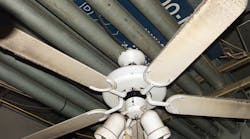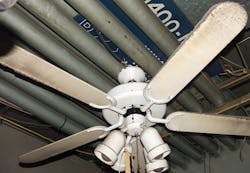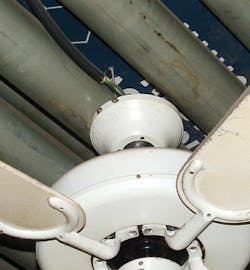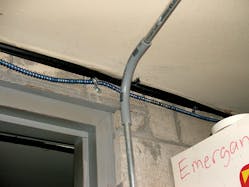A Photo From My Fan Club
This floppy paddle fan was installed without any box. Instead, the installer used toggle bolts to secure the mounting bracket directly to a real estate sign precariously positioned above those 4-in. raceways. No wonder the maintenance manager called to complain that his fan was “wobbling like crazy!”
The fan was wired with SJO type cord, which was simply thrown over the top of the raceways and then connected to a surface-mounted switch box on the wall. Using flexible cord in this manner is a violation of 400.8(1), which does not permit flexible cords to be used as a substitute for a fixed wiring method.
The installer also violated the intent of 422.18, which requires ceiling-suspended paddle fans to be supported independently of an outlet box, or by securing the fan to a listed outlet box identified for the support of paddle fans. Since no box was used for the bracket or to enclose the splices, we could argue that 300.15 has also been violated — because that section of the Code requires a box or conduit body to be installed where splices are made in cable-type wiring methods.
Mix and Match Mess
Apparently, whoever installed this pipe run couldn’t make up their mind whether to use EMT or PVC. Unfortunately, he or she also decided not to use any connectors or couplings to attach these two different types of raceways. Simply shoving the EMT into a factory-made PVC 90° elbow seemed like a much better idea!
Maybe the installer ran out of parts or simply could not bend the EMT. But no matter what the reason, he or she violated the rules of 300.10, because the EMT raceways are not “metallically joined together into a continuous electrical conductor.” Section 300.10 also requires raceways to be “mechanically secured to boxes, fittings, cabinets, and other enclosures.” Although you can’t see it in this photo, there were no mechanical connections made between any of these raceway sections or where the EMT connected to the boxes at the ends of the run.
We can also cite a violation of 250.120(A), because it requires, in part, equipment grounding conductors, where consisting of metal raceways, to be installed “using fittings for joints and terminations approved for the use” with the raceways used. It also requires “connections, joints, and fittings to be made tight using suitable tools.”
Lastly, 250.4(A)(3) requires the EMT to be bonded together and to the supply source to create an “effective ground fault current path.”







